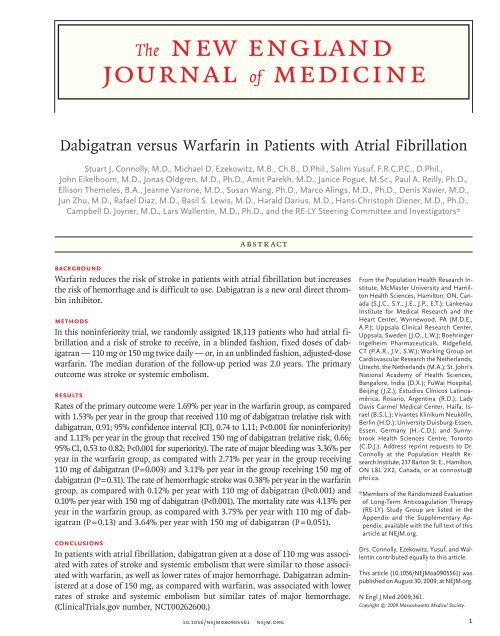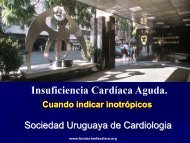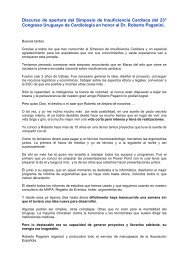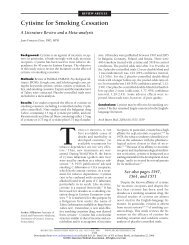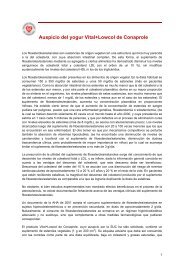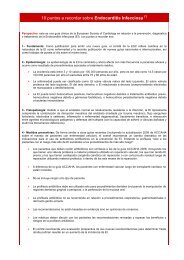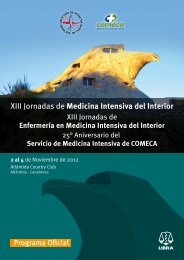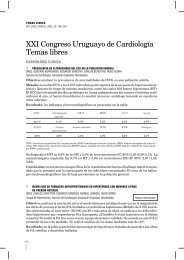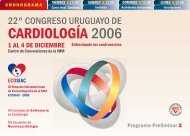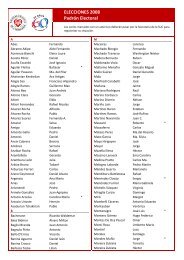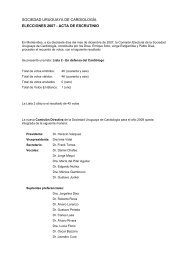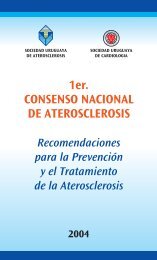The new england journal of medicine
The new england journal of medicine
The new england journal of medicine
You also want an ePaper? Increase the reach of your titles
YUMPU automatically turns print PDFs into web optimized ePapers that Google loves.
<strong>The</strong> <strong>new</strong> <strong>england</strong><br />
<strong>journal</strong> <strong>of</strong> <strong>medicine</strong><br />
Dabigatran versus Warfarin in Patients with Atrial Fibrillation<br />
Stuart J. Connolly, M.D., Michael D. Ezekowitz, M.B., Ch.B., D.Phil., Salim Yusuf, F.R.C.P.C., D.Phil.,<br />
John Eikelboom, M.D., Jonas Oldgren, M.D., Ph.D., Amit Parekh, M.D., Janice Pogue, M.Sc., Paul A. Reilly, Ph.D.,<br />
Ellison <strong>The</strong>meles, B.A., Jeanne Varrone, M.D., Susan Wang, Ph.D., Marco Alings, M.D., Ph.D., Denis Xavier, M.D.,<br />
Jun Zhu, M.D., Rafael Diaz, M.D., Basil S. Lewis, M.D., Harald Darius, M.D., Hans-Christoph Diener, M.D., Ph.D.,<br />
Campbell D. Joyner, M.D., Lars Wallentin, M.D., Ph.D., and the RE-LY Steering Committee and Investigators*<br />
Abstract<br />
Background<br />
Warfarin reduces the risk <strong>of</strong> stroke in patients with atrial fibrillation but increases<br />
the risk <strong>of</strong> hemorrhage and is difficult to use. Dabigatran is a <strong>new</strong> oral direct thrombin<br />
inhibitor.<br />
Methods<br />
In this noninferiority trial, we randomly assigned 18,113 patients who had atrial fibrillation<br />
and a risk <strong>of</strong> stroke to receive, in a blinded fashion, fixed doses <strong>of</strong> dabigatran<br />
— 110 mg or 150 mg twice daily — or, in an unblinded fashion, adjusted-dose<br />
warfarin. <strong>The</strong> median duration <strong>of</strong> the follow-up period was 2.0 years. <strong>The</strong> primary<br />
outcome was stroke or systemic embolism.<br />
Results<br />
Rates <strong>of</strong> the primary outcome were 1.69% per year in the warfarin group, as compared<br />
with 1.53% per year in the group that received 110 mg <strong>of</strong> dabigatran (relative risk with<br />
dabigatran, 0.91; 95% confidence interval [CI], 0.74 to 1.11; P
<strong>The</strong> <strong>new</strong> <strong>england</strong> <strong>journal</strong> <strong>of</strong> <strong>medicine</strong><br />
Atrial fibrillation increases the<br />
risks <strong>of</strong> stroke and death. Vitamin K antagonists,<br />
such as warfarin, reduce the risks<br />
<strong>of</strong> stroke and death but increase the risk <strong>of</strong> hemorrhage<br />
as compared with control therapy. 1 <strong>The</strong>refore,<br />
warfarin is recommended for patients who<br />
have atrial fibrillation and are at risk for stroke. 2<br />
Vitamin K antagonists are cumbersome to use,<br />
because <strong>of</strong> their multiple interactions with food<br />
and drugs, and they require frequent laboratory<br />
monitoring. <strong>The</strong>refore, they are <strong>of</strong>ten not used,<br />
and when they are, rates <strong>of</strong> discontinuation are<br />
high. 3,4 Many patients receiving warfarin still have<br />
inadequate anticoagulation. 5 Thus, there is a need<br />
for <strong>new</strong> anticoagulant agents that are effective,<br />
safe, and convenient to use.<br />
Dabigatran etexilate is an oral prodrug that is<br />
rapidly converted by a serum esterase to dabigatran,<br />
a potent, direct, competitive inhibitor <strong>of</strong><br />
thrombin. It has an absolute bioavailability <strong>of</strong><br />
6.5%, 80% <strong>of</strong> the given dose is excreted by the<br />
kidneys, its serum half-life is 12 to 17 hours, and<br />
it does not require regular monitoring. 6 Dabigatran<br />
has been evaluated in a pilot trial involving<br />
patients with atrial fibrillation and in a study for<br />
the prevention <strong>of</strong> venous thromboembolism, in<br />
which doses <strong>of</strong> 150 mg twice daily and 220 mg<br />
once daily, respectively, were promising. 7,8 We performed<br />
a large, randomized trial comparing the<br />
use <strong>of</strong> dabigatran, at doses <strong>of</strong> 110 mg twice daily<br />
and 150 mg twice daily, with warfarin.<br />
Methods<br />
Trial Design<br />
<strong>The</strong> Randomized Evaluation <strong>of</strong> Long-Term Anticoagulation<br />
<strong>The</strong>rapy (RE-LY) was a randomized<br />
trial designed to compare two fixed doses <strong>of</strong> dabigatran,<br />
each administered in a blinded manner,<br />
with open-label use <strong>of</strong> warfarin in patients who<br />
had atrial fibrillation and were at increased risk<br />
for stroke. <strong>The</strong> design <strong>of</strong> this study has been described<br />
previously. 9<br />
<strong>The</strong> study was funded by Boehringer Ingelheim<br />
and was coordinated by the Population Health<br />
Research Institute (Hamilton, ON, Canada), which<br />
independently managed the database and performed<br />
the primary data analyses. An operations<br />
committee, with assistance from an international<br />
steering committee and with participation by the<br />
sponsor, was responsible for the design, conduct,<br />
and reporting <strong>of</strong> the study. <strong>The</strong> study was approved<br />
by all appropriate national regulatory authorities<br />
and ethics committees <strong>of</strong> the participating centers.<br />
All the authors vouch for the accuracy and completeness<br />
<strong>of</strong> the data and the analyses.<br />
Study Participants<br />
Patients were recruited from 951 clinical centers<br />
in 44 countries. In brief, patients were eligible if<br />
they had atrial fibrillation documented on electrocardiography<br />
performed at screening or within<br />
6 months beforehand and at least one <strong>of</strong> the<br />
following characteristics: previous stroke or transient<br />
ischemic attack, a left ventricular ejection<br />
fraction <strong>of</strong> less than 40%, New York Heart Association<br />
class II or higher heart-failure symptoms<br />
within 6 months before screening, and an age <strong>of</strong><br />
at least 75 years or an age <strong>of</strong> 65 to 74 years plus<br />
diabetes mellitus, hypertension, or coronary artery<br />
disease. Reasons for exclusion were the presence<br />
<strong>of</strong> a severe heart-valve disorder, stroke within<br />
14 days or severe stroke within 6 months before<br />
screening, a condition that increased the risk <strong>of</strong><br />
hemorrhage, a creatinine clearance <strong>of</strong> less than<br />
30 ml per minute, active liver disease, and pregnancy.<br />
(Detailed inclusion and exclusion criteria<br />
are available in Tables 1 and 2 <strong>of</strong> the Supplementary<br />
Appendix, available with the full text <strong>of</strong> this<br />
article at NEJM.org.)<br />
Procedures<br />
After providing written informed consent, all trial<br />
participants were randomly assigned to receive<br />
one <strong>of</strong> two doses <strong>of</strong> dabigatran, or to receive warfarin,<br />
by means <strong>of</strong> a central, interactive, automated<br />
telephone system. Dabigatran was administered, in<br />
a blinded fashion, in capsules containing either<br />
110 mg or 150 mg <strong>of</strong> the drug, to be taken twice<br />
daily. Warfarin was administered, in an unblinded<br />
fashion, in tablets <strong>of</strong> 1, 3, or 5 mg and was<br />
adjusted locally to an international normalized<br />
ratio (INR) <strong>of</strong> 2.0 to 3.0, with the INR measured<br />
at least monthly. <strong>The</strong> time that the INR was within<br />
the therapeutic range was calculated with the<br />
use <strong>of</strong> the method <strong>of</strong> Rosendaal et al., 10 excluding<br />
INRs from the first week and after discontinuation<br />
<strong>of</strong> the study drug. <strong>The</strong>se data were reported<br />
back to the participating centers with advice<br />
for optimal INR control. Concomitant use <strong>of</strong> aspirin<br />
(at a dose <strong>of</strong>
Dabigatran in Atrial Fibrillation<br />
permitted until 2 years after the trial started, when<br />
the protocol was amended to prohibit its use, because<br />
<strong>of</strong> its potential to interact with dabigatran.<br />
Follow-up visits occurred 14 days after randomization,<br />
at 1 and 3 months, every 3 months<br />
thereafter in the first year, and then every 4<br />
months until the study ended. Liver-function testing<br />
was performed monthly during the first year<br />
<strong>of</strong> the follow-up period. On the basis <strong>of</strong> a prespecified<br />
evaluation <strong>of</strong> liver-function tests in at<br />
least 6000 patients in the dabigatran group after<br />
they had been followed for 6 months or more,<br />
the data safety monitoring board recommended<br />
that the frequency <strong>of</strong> liver-function testing be reduced,<br />
with such testing performed only at the<br />
regular visits.<br />
Outcomes<br />
<strong>The</strong> primary study outcome was stroke or systemic<br />
embolism. <strong>The</strong> primary safety outcome was major<br />
hemorrhage. Secondary outcomes were stroke,<br />
systemic embolism, and death. Other outcomes<br />
were myocardial infarction, pulmonary embolism,<br />
transient ischemic attack, and hospitalization. <strong>The</strong><br />
primary net clinical benefit outcome was the composite<br />
<strong>of</strong> stroke, systemic embolism, pulmonary<br />
embolism, myocardial infarction, death, or major<br />
hemorrhage. Stroke was defined as the sudden onset<br />
<strong>of</strong> a focal neurologic deficit in a location consistent<br />
with the territory <strong>of</strong> a major cerebral artery<br />
and categorized as ischemic, hemorrhagic, or<br />
unspecified. Hemorrhagic transformation <strong>of</strong> ischemic<br />
stroke was not considered to be hemorrhagic<br />
stroke. Intracranial hemorrhage consisted <strong>of</strong> hemorrhagic<br />
stroke and subdural or subarachnoid<br />
hemorrhage. Systemic embolism was defined as<br />
an acute vascular occlusion <strong>of</strong> an extremity or organ,<br />
documented by means <strong>of</strong> imaging, surgery,<br />
or autopsy. Major bleeding was defined as a reduction<br />
in the hemoglobin level <strong>of</strong> at least 20 g<br />
per liter, transfusion <strong>of</strong> at least 2 units <strong>of</strong> blood,<br />
or symptomatic bleeding in a critical area or organ.<br />
Life-threatening bleeding was a subcategory<br />
<strong>of</strong> major bleeding that consisted <strong>of</strong> fatal bleeding,<br />
symptomatic intracranial bleeding, bleeding<br />
with a decrease in the hemoglobin level <strong>of</strong> at least<br />
50 g per liter, or bleeding requiring transfusion<br />
<strong>of</strong> at least 4 units <strong>of</strong> blood or inotropic agents or<br />
necessitating surgery. All other bleeding was considered<br />
minor.<br />
An international team <strong>of</strong> adjudicators reviewed<br />
documents in local languages after blinding, or<br />
documents were translated by an independent<br />
group and were centrally blinded. Each primary<br />
and secondary outcome event was adjudicated by<br />
two independent investigators who were unaware<br />
<strong>of</strong> the treatment assignments. All transient ischemic<br />
attacks were reviewed to ensure that strokes<br />
had not been missed. To detect possible unreported<br />
events, symptom questionnaires were regularly<br />
administered to patients, and adverse-event<br />
and hospitalization reports were scrutinized for<br />
unreported primary or secondary outcomes.<br />
Statistical Analysis<br />
<strong>The</strong> primary analysis was designed to test whether<br />
either dose <strong>of</strong> dabigatran was noninferior to<br />
warfarin, as evaluated with the use <strong>of</strong> Cox proportional-hazards<br />
modeling. To satisfy the noninferiority<br />
hypothesis, the upper bound <strong>of</strong> the onesided<br />
97.5% confidence interval for the relative<br />
risk <strong>of</strong> an outcome with dabigatran as compared<br />
with warfarin needed to fall below 1.46. This noninferiority<br />
margin was derived from a meta-analysis<br />
<strong>of</strong> trials <strong>of</strong> vitamin K antagonists as compared<br />
with control therapy in patients with atrial fibrillation,<br />
with the margin defined according to the<br />
upper bound <strong>of</strong> the 95% confidence interval for<br />
the relative risk <strong>of</strong> the primary outcome in the control<br />
group versus the warfarin group. 11 <strong>The</strong> margin<br />
<strong>of</strong> 1.46 represents half the 95% confidence<br />
interval <strong>of</strong> the estimated effect <strong>of</strong> control therapy<br />
over warfarin. To account for testing <strong>of</strong> both dabigatran<br />
doses against warfarin, we planned to determine<br />
whether the higher <strong>of</strong> the two one-sided<br />
P values for the two doses was less than 0.025, in<br />
which case both treatments would be declared to<br />
be noninferior. If the higher <strong>of</strong> the two one-sided<br />
P values was 0.025 or greater, the lower <strong>of</strong> the<br />
two was required to be less than 0.0125 to permit<br />
a claim <strong>of</strong> statistical significance. All analyses<br />
were based on the intention-to-treat principle. After<br />
noninferiority <strong>of</strong> both doses <strong>of</strong> dabigatran was<br />
established, all subsequent P values were reported<br />
for two-tailed tests <strong>of</strong> superiority. Cox regression<br />
was used to calculate relative risks, confidence intervals,<br />
and P values. Chi-square testing was used<br />
to compare rates <strong>of</strong> medication discontinuation<br />
and adverse events.<br />
We planned to enroll 15,000 patients, an enrollment<br />
that we estimated would provide 84%<br />
power to evaluate the noninferiority <strong>of</strong> each dose<br />
10.1056/nejmoa0905561 nejm.org 3
<strong>The</strong> <strong>new</strong> <strong>england</strong> <strong>journal</strong> <strong>of</strong> <strong>medicine</strong><br />
<strong>of</strong> dabigatran. Two protocol changes were made by<br />
the operations committee during the enrollment<br />
period, without knowledge <strong>of</strong> emerging treatment<br />
effects. <strong>The</strong>se were the enforcement <strong>of</strong> balanced<br />
enrollment <strong>of</strong> patients who had not received longterm<br />
therapy with a vitamin K antagonist (i.e.,<br />
had a total lifetime use <strong>of</strong>
Dabigatran in Atrial Fibrillation<br />
Table 1. Baseline Characteristics <strong>of</strong> the Study Participants, According to Treatment Group.*<br />
Characteristic<br />
Dabigatran,<br />
110 mg<br />
Dabigatran,<br />
150 mg Warfarin<br />
Age — yr 71.4±8.6 71.5±8.8 71.6±8.6<br />
Weight — kg 82.9±19.9 82.5±19.4 82.7±19.7<br />
Blood pressure — mm Hg<br />
Systolic 130.8±17.5 131.0±17.6 131.2±17.4<br />
Diastolic 77.0±10.6 77.0±10.6 77.1±10.4<br />
Male sex — no./total no. (%) 3865/6015 (64.3) 3840/6076 (63.2) 3809/6022 (63.3)<br />
Type <strong>of</strong> atrial fibrillation — no./total no. (%)<br />
Persistent 1950/6011 (32.4) 1909/6075 (31.4) 1930/6021 (32.0)<br />
Paroxysmal 1929/6011 (32.1) 1978/6075 (32.6) 2036/6021 (33.8)<br />
Permanent 2132/6011 (35.4) 2188/6075 (36.0) 2055/6021 (34.1)<br />
CHADS 2 score† 2.1±1.1 2.2±1.2 2.1±1.1<br />
0 or 1 — no./total no. (%) 1958/6014 (32.6) 1958/6076 (32.2) 1859/6022 (30.9)<br />
2 — no./total no. (%) 2088/6014 (34.7) 2137/6076 (35.2) 2230/6022 (37.0)<br />
3–6 — no./total no. (%) 1968/6014 (32.7) 1981/6076 (32.6) 1933/6022 (32.1)<br />
Previous stroke or transient ischemic attack — no./total<br />
no. (%)<br />
1195/6015 (19.9) 1233/6076 (20.3) 1195/6022 (19.8)<br />
Prior myocardial infarction — no./total no. (%) 1008/6015 (16.8) 1029/6076 (16.9) 968/6022 (16.1)<br />
Heart failure — no./total no. (%) 1937/6015 (32.2) 1934/6076 (31.8) 1922/6022 (31.9)<br />
Diabetes mellitus — no./total no. (%) 1409/6015 (23.4) 1402/6076 (23.1) 1410/6022 (23.4)<br />
Hypertension — no./total no. (%) 4738/6015 (78.8) 4795/6076 (78.9) 4750/6022 (78.9)<br />
Medications in use at baseline — no./total no. (%)<br />
Aspirin 2404/6013 (40.0) 2352/6075 (38.7) 2442/6017 (40.6)<br />
ARB or ACE inhibitor 3987/6013 (66.3) 4053/6075 (66.7) 3939/6017 (65.5)<br />
Beta-blocker 3784/6013 (62.9) 3872/6075 (63.7) 3719/6017 (61.8)<br />
Amiodarone 624/6013 (10.4) 665/6075 (10.9) 644/6017 (10.7)<br />
Statin‡ 2698/6013 (44.9) 2667/6075 (43.9) 2673/6017 (44.4)<br />
Proton-pump inhibitor 812/6013 (13.5) 847/6075 (13.9) 832/6017 (13.8)<br />
H 2 -receptor antagonist 225/6013 (3.7) 241/6075 (4.0) 256/6017 (4.3)<br />
Long-term VKA therapy 3011/6015 (50.1) 3049/6076 (50.2) 2929/6022 (48.6)<br />
* Plus-minus values are means ±SD. ARB denotes angiotensin-receptor blocker, and ACE angiotensin-converting<br />
enzyme.<br />
† <strong>The</strong> CHADS 2 score is a measure <strong>of</strong> the risk <strong>of</strong> stroke in which congestive heart failure, hypertension, an age <strong>of</strong> 75 years<br />
or older, and diabetes mellitus are each assigned 1 point and previous stroke or transient ischemic attack is assigned<br />
2 points; the score is calculated by summing all the points for a given patient. 12<br />
‡ Statins are defined here as 3-hydroxy-3-methylglutaryl–coenzyme A reductase inhibitors.<br />
§ Long-term therapy with a vitamin K antagonist (VKA) denotes a total lifetime use <strong>of</strong> a VKA <strong>of</strong> 61 or more days.<br />
tran, 0.92; 95% CI, 0.84 to 1.02; P = 0.10) and 6.91%<br />
per year with 150 mg <strong>of</strong> dabigatran (relative risk,<br />
0.91; 95% CI, 0.82 to 1.00; P = 0.04).<br />
Comparison <strong>of</strong> Dabigatran Doses<br />
As compared with the 110-mg dose, administration<br />
<strong>of</strong> the 150-mg dose <strong>of</strong> dabigatran reduced the<br />
risk <strong>of</strong> stroke or systemic embolism (P = 0.005).<br />
This difference was driven mostly by a decrease<br />
in the rate <strong>of</strong> stroke with ischemic or unspecified<br />
cause, whereas rates <strong>of</strong> hemorrhagic stroke were<br />
similar in the two dabigatran groups. <strong>The</strong>re was<br />
no significant difference in the rates <strong>of</strong> death from<br />
either vascular causes or any cause between the<br />
two doses. On the other hand, as compared with<br />
the 110-mg dose, the 150-mg dose <strong>of</strong> dabigatran<br />
10.1056/nejmoa0905561 nejm.org 5
<strong>The</strong> <strong>new</strong> <strong>england</strong> <strong>journal</strong> <strong>of</strong> <strong>medicine</strong><br />
Table 2. Efficacy Outcomes, According to Treatment Group.<br />
Event<br />
Dabigatran, 110 mg<br />
(N = 6015)<br />
Dabigatran, 150 mg<br />
(N = 6076)<br />
Warfarin<br />
(N = 6022)<br />
Dabigatran, 110 mg,<br />
vs. Warfarin<br />
Relative Risk<br />
(95% CI) P Value<br />
Dabigatran, 150 mg,<br />
vs. Warfarin<br />
Relative Risk<br />
(95% CI) P Value<br />
Dabigatran,<br />
150 mg vs. 110 mg<br />
Relative Risk<br />
(95% CI) P Value<br />
Stroke or systemic<br />
embolism*<br />
no. <strong>of</strong><br />
patients %/yr<br />
no. <strong>of</strong><br />
patients %/yr<br />
no. <strong>of</strong><br />
patients %/yr<br />
182 1.53 134 1.11 199 1.69 0.91 (0.74–1.11)
Dabigatran in Atrial Fibrillation<br />
1.0<br />
0.05<br />
Cumulative Hazard Rate<br />
0.8<br />
0.6<br />
0.4<br />
0.2<br />
0.04<br />
0.03<br />
0.02<br />
0.01<br />
Dabigatran,<br />
110 mg<br />
Warfarin<br />
Dabigatran,<br />
150 mg<br />
0.00<br />
0 6 12 18 24 30<br />
No. at Risk<br />
Warfarin<br />
Dabigatran, 110 mg<br />
Dabigatran, 150 mg<br />
0.0<br />
0 6 12 18 24 30<br />
6022<br />
6015<br />
6076<br />
5862<br />
5862<br />
5939<br />
5718<br />
5710<br />
5779<br />
Months<br />
4593<br />
4593<br />
4682<br />
2890<br />
2945<br />
3044<br />
1322<br />
1385<br />
1429<br />
Figure 1. Cumulative Hazard Rates for the AUTHOR: Primary Connolly Outcome <strong>of</strong> Stroke or RETAKE Systemic 1st Embolism, According to Treatment<br />
Group.<br />
ICM<br />
REG F FIGURE: 1 <strong>of</strong> 2<br />
2nd<br />
3rd<br />
CASE<br />
Revised<br />
EMail<br />
Line 4-C<br />
SIZE<br />
H/T<br />
Combo<br />
AUTHOR, PLEASE NOTE:<br />
Figure has been redrawn and type has been reset.<br />
Please check carefully.<br />
was associated with a trend toward ARTIST: an increased ts<br />
Enon<br />
risk <strong>of</strong> major bleeding (P = 0.052) and also with<br />
increased risks <strong>of</strong> gastrointestinal, minor, and any<br />
bleeding. <strong>The</strong> net clinical benefit was almost identical<br />
for the two doses.<br />
JOB: 36112 ISSUE: 09-17-09<br />
Adverse Events and Liver Function<br />
<strong>The</strong> only adverse effect that was significantly more<br />
common with dabigatran than with warfarin was<br />
dyspepsia (Table 4). Dyspepsia occurred in 348<br />
patients (5.8%) in the warfarin group and in 707<br />
patients (11.8%) and 688 patients (11.3%) in the<br />
110-mg and 150-mg dabigatran groups, respectively<br />
(P
<strong>The</strong> <strong>new</strong> <strong>england</strong> <strong>journal</strong> <strong>of</strong> <strong>medicine</strong><br />
Table 3. Safety Outcomes, According to Treatment Group.*<br />
Event Dabigatran, 110 mg Dabigatran, 150 mg Warfarin<br />
Dabigatran, 110 mg,<br />
vs. Warfarin<br />
Relative Risk<br />
(95% CI) P Value<br />
Dabigatran, 150 mg,<br />
vs. Warfarin<br />
Relative Risk<br />
(95% CI) P Value<br />
Dabigatran,<br />
150 mg vs. 110 mg<br />
Relative Risk<br />
(95% CI) P Value<br />
no. <strong>of</strong><br />
patients %/yr<br />
no. <strong>of</strong><br />
patients %/yr<br />
no. <strong>of</strong><br />
patients %/yr<br />
Major bleeding 322 2.71 375 3.11 397 3.36 0.80 (0.69–0.93) 0.003 0.93 (0.81–1.07) 0.31 1.16 (1.00–1.34) 0.052<br />
Life threatening 145 1.22 175 1.45 212 1.80 0.68 (0.55–0.83)
Dabigatran in Atrial Fibrillation<br />
Table 4. Discontinuation <strong>of</strong> the Study Drug, Adverse Events, and Liver Function According to Treatment Group.*<br />
Variable<br />
Dabigatran, 110 mg<br />
(N = 6015)<br />
Dabigatran, 150 mg<br />
(N = 6076) Warfarin (N = 6022)<br />
number <strong>of</strong> patients (percent)<br />
Study-drug discontinuation<br />
Discontinued at 1 yr† 862 (15) 935 (16) 608 (10)<br />
Discontinued at 2 yr† 1161 (21) 1211 (21) 902 (17)<br />
Reason for discontinuation<br />
Patient’s decision 440 (7.3) 474 (7.8) 375 (6.2)<br />
Outcome event 192 (3.2) 164 (2.7) 130 (2.2)<br />
Serious adverse event‡ 163 (2.7) 166 (2.7) 105 (1.7)<br />
Gastrointestinal symptoms§ 134 (2.2) 130 (2.1) 38 (0.6)<br />
Gastrointestinal bleeding 58 (1.0) 80 (1.3) 54 (0.9)<br />
Adverse events<br />
Dyspepsia‡‖ 707 (11.8) 688 (11.3) 348 (5.8)<br />
Dizziness 486 (8.1) 506 (8.3) 568 (9.4)<br />
Dyspnea 557 (9.3) 580 (9.5) 586 (9.7)<br />
Peripheral edema 473 (7.9) 478 (7.9) 468 (7.8)<br />
Fatigue 399 (6.6) 401 (6.6) 372 (6.2)<br />
Cough 344 (5.7) 348 (5.7) 364 (6.0)<br />
Chest pain 312 (5.2) 377 (6.2) 357 (5.9)<br />
Back pain 316 (5.3) 314 (5.2) 337 (5.6)<br />
Arthralgia 270 (4.5) 335 (5.5) 346 (5.7)<br />
Nasopharyngitis 337 (5.6) 330 (5.4) 336 (5.6)<br />
Diarrhea 377 (6.3) 397 (6.5) 346 (5.7)<br />
Atrial fibrillation 330 (5.5) 357 (5.9) 349 (5.8)<br />
Urinary tract infection 273 (4.5) 289 (4.8) 335 (5.6)<br />
Upper respiratory tract infection 288 (4.8) 285 (4.7) 313 (5.2)<br />
Liver function<br />
ALT or AST >3× ULN 124 (2.1) 117 (1.9) 132 (2.2)<br />
ALT or AST >3× ULN with concurrent<br />
13 (0.2) 13 (0.2) 21 (0.3)<br />
bilirubin >2× ULN<br />
Hepatobiliary disorder**<br />
Serious adverse event 33 (0.5) 34 (0.6) 33 (0.5)<br />
Non–serious adverse event 101 (1.7) 109 (1.8) 112 (1.9)<br />
* ALT denotes alanine aminotransferase, AST aspartate aminotransferase, and ULN upper limit <strong>of</strong> the normal range.<br />
† Rates <strong>of</strong> discontinuation at 1 and 2 years were higher with dabigatran than with warfarin (P
<strong>The</strong> <strong>new</strong> <strong>england</strong> <strong>journal</strong> <strong>of</strong> <strong>medicine</strong><br />
Figure 2 (facing page). Relative Risk <strong>of</strong> the Primary Outcome<br />
<strong>of</strong> Stroke or Systemic Embolism with Dabigatran<br />
versus Warfarin, According to Subgroup.<br />
Ethnic group was self-reported. Long-term therapy with<br />
a vitamin K antagonist (VKA) denotes a total lifetime<br />
use <strong>of</strong> a VKA <strong>of</strong> 61 days or more. <strong>The</strong> body-mass index<br />
is the weight in kilograms divided by the square <strong>of</strong> the<br />
height in meters. <strong>The</strong> CHADS 2 score is a measure <strong>of</strong><br />
the risk <strong>of</strong> stroke in which congestive heart failure, hypertension,<br />
an age <strong>of</strong> 75 years or older, and diabetes<br />
mellitus are each assigned 1 point and previous stroke<br />
or transient ischemic attack is assigned 2 points; the<br />
score is calculated by summing all the points for a given<br />
patient. 12 Creatinine clearance was calculated according<br />
to the Cockcr<strong>of</strong>t–Gault method. <strong>The</strong> squares<br />
with horizontal lines are hazard ratios and corresponding<br />
95% confidence intervals; the sizes <strong>of</strong> squares are<br />
proportional to the sizes <strong>of</strong> the subgroups. PPI denotes<br />
proton-pump inhibitor.<br />
Ximelagatran, an earlier direct thrombin inhibitor,<br />
appeared to be similar to warfarin with respect<br />
to efficacy and safety but was found to be hepatotoxic.<br />
16 In our serial measurement <strong>of</strong> liver function,<br />
we did not find evidence <strong>of</strong> hepatotoxicity<br />
with dabigatran.<br />
<strong>The</strong> rate <strong>of</strong> myocardial infarction was higher<br />
with both doses <strong>of</strong> dabigatran than with warfarin.<br />
An explanation might be that warfarin provides<br />
better protection against coronary ischemic events<br />
than dabigatran, and warfarin is known to reduce<br />
the risk <strong>of</strong> myocardial infarction. 17 However, rates<br />
<strong>of</strong> myocardial infarction were similar between patients<br />
with atrial fibrillation who were receiving<br />
warfarin and those who were receiving ximelagatran,<br />
another direct thrombin inhibitor. 16 <strong>The</strong> explanation<br />
for this finding is therefore uncertain.<br />
<strong>The</strong> most devastating complication <strong>of</strong> warfarin<br />
therapy is intracranial hemorrhage, especially hemorrhagic<br />
stroke. As compared with aspirin, warfarin<br />
doubles the risk <strong>of</strong> intracranial hemorrhage. 1<br />
Thus, our finding that the rate <strong>of</strong> this complication<br />
with both doses <strong>of</strong> dabigatran was less than<br />
one third the rate with warfarin, without a reduction<br />
in the efficacy against ischemic stroke, suggests<br />
an important advantage <strong>of</strong> dabigatran. <strong>The</strong><br />
rate <strong>of</strong> major bleeding with warfarin was higher<br />
in our study than in some previous trials. 11,13,14<br />
This is partly explained by the more inclusive definition<br />
<strong>of</strong> major bleeding in our study. <strong>The</strong>re was<br />
an increase in the rate <strong>of</strong> gastrointestinal bleeding<br />
with the higher dabigatran dose, despite the<br />
overall lower rates <strong>of</strong> bleeding at other sites. To<br />
enhance absorption <strong>of</strong> dabigatran, a low pH is required.<br />
<strong>The</strong>refore, dabigatran capsules contain<br />
dabigatran-coated pellets with a tartaric acid core.<br />
This acidity may partly explain the increased incidence<br />
<strong>of</strong> dyspeptic symptoms with both dabigatran<br />
doses and the increased risk <strong>of</strong> gastrointestinal<br />
bleeding with the 150-mg dose.<br />
<strong>The</strong> benefit <strong>of</strong> dabigatran may be explained in<br />
part by the twice-daily dosing regimen. Since dabigatran<br />
has an elimination half-life <strong>of</strong> 12 to 17<br />
hours, twice-daily dosing reduces variability in the<br />
anticoagulation effect, especially as compared with<br />
the anticoagulation effect <strong>of</strong> warfarin, which is<br />
difficult to control. Warfarin broadly inhibits coagulation<br />
(inhibiting factors II, VII, IX, and X and<br />
proteins C and S). By selectively inhibiting only<br />
thrombin, dabigatran may have antithrombotic efficacy<br />
while preserving some other hemostatic<br />
mechanisms in the coagulation system and thus<br />
potentially mitigating the risk <strong>of</strong> bleeding.<br />
<strong>The</strong> use <strong>of</strong> open-label warfarin could have introduced<br />
a bias in the reporting or adjudication<br />
<strong>of</strong> events. This risk was reduced by the implementation<br />
<strong>of</strong> several validated procedures, including<br />
blinded evaluation <strong>of</strong> outcome events. <strong>The</strong> unexpectedly<br />
different rates <strong>of</strong> myocardial infarction<br />
and gastrointestinal bleeding among the three<br />
treatment groups support an absence <strong>of</strong> bias.<br />
Control <strong>of</strong> anticoagulation with warfarin in our<br />
study was similar to that in previous international<br />
clinical trials, even though half our patients had<br />
not previously had extensive treatment with warfarin.<br />
10,17<br />
<strong>The</strong> net clinical benefit outcome, which is a<br />
measure <strong>of</strong> the overall benefit and risk, was similar<br />
between the two doses <strong>of</strong> dabigatran, owing<br />
to the lower risk <strong>of</strong> ischemia with the 150-mg<br />
dose and the lower risk <strong>of</strong> hemorrhage with the<br />
110-mg dose. <strong>The</strong>se findings suggest that the dose<br />
<strong>of</strong> dabigatran could potentially be tailored to take<br />
into consideration the risk characteristics <strong>of</strong> a specific<br />
patient, although this concept was not specifically<br />
tested in our trial.<br />
In conclusion, we compared two doses <strong>of</strong> dabigatran<br />
with warfarin in patients who had atrial<br />
fibrillation and who were at risk for stroke. As<br />
compared with warfarin, the 110-mg dose <strong>of</strong> dabigatran<br />
was associated with similar rates <strong>of</strong> stroke<br />
and systemic embolism and lower rates <strong>of</strong> major<br />
10<br />
10.1056/nejmoa0905561<br />
nejm.org
Dabigatran in Atrial Fibrillation<br />
Subgroup<br />
All patients<br />
Long-term VKA therapy<br />
No<br />
Yes<br />
Sex<br />
Male<br />
Female<br />
Body-mass index<br />
<strong>The</strong> <strong>new</strong> <strong>england</strong> <strong>journal</strong> <strong>of</strong> <strong>medicine</strong><br />
hemorrhage; the 150-mg dose <strong>of</strong> dabigatran was<br />
associated with lower rates <strong>of</strong> stroke and systemic<br />
embolism but with a similar rate <strong>of</strong> major hemorrhage.<br />
Supported by a grant from Boehringer Ingelheim.<br />
Dr. Connolly reports receiving consulting fees, lecture fees,<br />
and grant support from Boehringer Ingelheim; Dr. Ezekowitz,<br />
consulting fees, lecture fees, and grant support from Boehringer<br />
Ingelheim and Aryx <strong>The</strong>rapeutics, consulting fees from San<strong>of</strong>i-<br />
Aventis, and lecture fees and grant support from Portola Pharmaceuticals;<br />
Dr. Yusuf, consulting fees, lecture fees and grant support<br />
from Boehringer Ingelheim and consulting fees from<br />
AstraZeneca, Bristol-Myers Squibb, and San<strong>of</strong>i-Aventis; Dr. Eikelboom,<br />
consulting fees, lecture fees, and grant support from<br />
Boehringer Ingelheim, AstraZeneca, San<strong>of</strong>i-Aventis, and Glaxo-<br />
SmithKline, consulting fees and lecture fees from Eisai Pharmaceuticals,<br />
Eli Lilly, and McNeil, and consulting fees from Bristol-<br />
Myers Squibb, Corgenix Medical Corporation, and Daiichi-Sankyo;<br />
Dr. Oldgren, consulting fees, lecture fees, and grant support from<br />
Boehringer Ingelheim and lecture fees from AstraZeneca; and<br />
Drs. Parekh and Xavier, grant support from Boehringer Ingelheim.<br />
Drs. Reilly, Varrone, and Wang report being employees<br />
<strong>of</strong> Boehringer Ingelheim. Drs. Alings and Zhu report receiving<br />
consulting fees and grant support from Boehringer Ingelheim;<br />
Dr. Diaz, consulting fees from GlaxoSmithKline, lecture fees<br />
from San<strong>of</strong>i-Aventis, GlaxoSmithKline, and Boehringer Ingelheim,<br />
and grant support from Boehringer Ingelheim; Dr.<br />
Lewis, consulting fees from San<strong>of</strong>i-Aventis, Bristol-Myers Squibb,<br />
and Boehringer Ingelheim and grant support from Boehringer<br />
Ingelheim; Dr. Darius, consulting fees, lecture fees, and grant<br />
support from Boehringer Ingelheim, consulting fees from San<strong>of</strong>i-<br />
Aventis and Bayer Schering Pharma, and lecture fees from the<br />
Medicines Company and Eli Lilly; Dr. Diener, consulting fees and<br />
lecture fees from Boehringer Ingelheim, Abbott, AstraZeneca,<br />
Bayer, Bristol-Myers Squibb, CoAxia, D-Pharm, Fresenius, Glaxo-<br />
SmithKline, Janssen Cilag, Merck Sharp and Dohme, MindFrame,<br />
Neurobiological Technologies, Novartis, Novo-Nordisk, Paion,<br />
Parke-Davis, Pfizer, San<strong>of</strong>i-Aventis, Sankyo, Servier, Solvay,<br />
Thrombogenics, Wyeth and Yamaguchi and grant support from<br />
Boehringer Ingelheim, AstraZeneca, GlaxoSmithKline, Novartis,<br />
Janssen-Cilag, and San<strong>of</strong>i-Aventis; Dr. Joyner, grant support from<br />
Boehringer Ingelheim, AstraZeneca, San<strong>of</strong>i-Aventis, and Bristol-<br />
Myers Squibb; and Dr. Wallentin, consulting fees, lecture fees,<br />
and grant support from Boehringer Ingelheim, consulting fees<br />
from Regado and Athera, lecture fees from Boehringer Ingelheim,<br />
Astra Zeneca, and Eli Lilly, and grant support from AstraZeneca,<br />
Bristol-Myers Squibb, GlaxoSmithKline, and Schering Plough. No<br />
other potential conflict <strong>of</strong> interest relevant to this article was reported.<br />
APPENDIX<br />
Members <strong>of</strong> the Randomized Evaluation <strong>of</strong> Long-Term Anticoagulation <strong>The</strong>rapy (RE-LY) Study Group are as follows (a full list <strong>of</strong> investigators<br />
is included in the Supplementary Appendix): Operations Committee: S.J. Connolly (principal investigator), M.D. Ezekowitz<br />
(principal investigator), S. Yusuf (chair, steering committee), J. Eikelboom, J. Oldgren, A. Parekh, P.A. Reilly, E. <strong>The</strong>meles, J. Varrone,<br />
S. Wang, E. Palmcrantz-Graf, M. Haehl, L. Wallentin (chair, steering committee). Steering Committee: A.M.W. Alings, J.V. Amerena,<br />
A. Avezum, I. Baumgartner, J. Brugada, A. Budaj, V. Caicedo, L. Ceremuzynski, J.H. Chen, P.J. Commerford, S.J. Connolly, A.L. Dans,<br />
H. Darius, G. Di Pasquale, R. Diaz, C. Erol, M.D. Ezekowitz, J. Ferreira, G.C. Flaker, M.D. Flather, M.G. Franzosi, R. Gamboa, S.P.<br />
Golitsyn, J.A. Gonzalez Hermosillo, D. Halon, H. Heidbuchel, S.H. Hohnloser, M. Hori, K. Huber, P. Jansky, G. Kamensky, M. Keltai,<br />
S. Kim, C.P. Lau, J.Y.F. Le Heuzey, B.S. Lewis, L.S. Liu, J. Nanas, J. Oldgren, O. Razali, P.S. Pais, A.N. Parkhomenko, K.E. Pedersen,<br />
L.S. Piegas, D. Raev, T.A. Simmers, P.J. Smith, M. Talajic, R.S. Tan, S. Tanomsup, L. Toivonen, D. Vinereanu, D. Xavier, L. Wallentin,<br />
S. Yusuf, J. Zhu. Core Adjudication–Stroke Advisory Committee: H.C. Diener (cochair), C.D. Joyner (cochair), A. Diehl, G. Ford, M.<br />
Robinson, J. Silva. Data Safety Monitoring Board: P. Sleight (cochair), D.G. Wyse (cochair), J. Collier, D. De Mets, J. Hirsh, E. Lesaffre,<br />
L. Ryden, P. Sandercock. Investigators who recruited at least 12 patients: Argentina: A. Caccavo, L. Cartasegna, C.A. Cuneo, M.V. Elizari,<br />
A.J. Gabito, M.A. Hominal, A.D. Hrabar, I.J. Mackinnon, M.A. Rodriguez, A.S. Sanchez, D.R. Vogel; Australia: D.M. Colquhoun, R.G.<br />
Lehman, B.B. Singh, J.H. Waites; Austria: F. Gazo, A. Podczeck, P. Siostrzonek; Belgium: J.L. Boland, A. de Meester, L. De Wolf, D.<br />
Dilling-Boer, M. Goethals, P. Goethals, O. Gurne, S. Hellemans, B. Ivan, M. Jottrand, I. Kersschot, F. Provenier, W. van Mieghem, Y.<br />
Vandekerckhove; Brazil: J.C.F. Braga, J.F. Kerr Saraiva, L.N. Maia, A.M. Lorga-Filho, C.S. Melo, D.B. Precoma, S. Rassi, P.R. Rossi;<br />
Bulgaria: E.S. Baldjiev, I.G. Filibev, N.N. Gotcheva, A.R. Goudev, D.T. Guenova, E.I. Manov, A.L. Radoslavov, D.A. Spirova, V.M.<br />
Tsanova, M.L. Tzekova; Canada: A.I. Bakbak, J.C. Berlingieri, K. Blackburn, A.W. Booth, S. Bose, P. Boucher, C. Constance, P. Costi, B.<br />
Coutu, M.S. Green, J. Habot, S. Kouz, A.V. Lalani, A.S. Lam, P.T.S. Ma, L.B. Mitchell, C.A. Morillo, G. O’Hara, A.S. Pandey, Y. Pesant,<br />
C.N. Powell, T.M. Rebane, D. Savard, S. Schulman, M.J. Sehl, D.S. Shu, L.D. Sterns, R. St.-Hilaire, G.S. Syan, P. Talbot, I. Teitelbaum,<br />
S.A. Vizel; China: X.J. Bai, W. Gao, Z.S. He, Q. Hua, W.M. Li, L. Li, G.P. Lu, S. Lv, N.L. Sun, N.F. Wang, Y.M. Yang, L. Zhang, F. Zhang;<br />
Czech Republic: J. Belohlavek, M. Cernohous, M. Choura, V. Dedek, B. Filipensky, K. Kovarova, Z. Poklopova, H. Skalicka, J. Spinar;<br />
Denmark: K.K. Dodt, K. Egstrup, S. Husted, K.K. Klarlund, S. Lind Rasmussen, T.M. Melchior, M.E. Olsen, N. Ralfkiaer, L.H. Rasmussen,<br />
K. Skagen; Finland: K.E. Airaksinen, H.V. Huikuri, M. Mänttäri, J.H. Melin, K. Peuhkurinen, V.K. Virtanen, A. Ylitalo; France: L.<br />
Boucher, A. Boye, P. Igigabel, C. Magnani, M. Martelet, J.E. Poulard; Germany: K.F. Appel, H. Darius, C.E.H. Dempfle, A. Dormann, J.<br />
Harenberg, W.L. Haverkamp, T. Horacek, D. Koudonas, J. Kreuzer, A. Müegge, T.F. Munzel, P.B. Salbach, W. Schoels, R. Veltkamp,<br />
E. Von Hodenberg; Greece: M.I. Anastasiou-Nana, K. Karamitsos, C. Lappas, A. Manolis; Hong Kong (China): W.K. Chan, H.F. Tse, P.T.<br />
Tsui, C.M. Yu; Hungary: A. Janosi, A. Kadar, P. Karpati, K. Keltai, J. Rapi, L.I. Regos, I. Szaka’l; India: R.K. Aggarwal, A. Bharani, J.S.<br />
Bhuvaneswaran, R.B. Byrapaneni, J.B. Gupta, K.K. Haridas, J. Hiremath, A.S. Jain, J. Joseph, A.M. Naik, R.B. Panwar, J.P.S. Sawhney,<br />
N. Sinha, A. Srinivas, P.S. Vadagenalli; Israel: J. Benhorin, N.M. Bornstein, B. Brenner, A. Butnaru, A. Caspi, M. Elias, E. Grossman, S.<br />
Hamoud, R. Ilia, E.I. Klainman, M. Lishner, C. Lotan, A. Marmor, M. Motro, L.H. Reisen, E. Schwammenthal, M. Shochat, B. Strasberg,<br />
Y. Turgeman, A.T. Weiss, D.H. Wexler, R. Wolff, D. Zeltser, R. Zimlichman; Italy: G. Argiolas, M. Barbiero, A. Fraticelli, M. Mennuni,<br />
L. Moretti, L. Mos, S. Pirelli; Japan: J. Furuya, S. Hara, M. Hiroe, S. Kakinoki, N. Miyamoto, M. Yokochi; South Korea: T.J. Cha, J.G. Cho,<br />
I.S. Choi, K.J. Choi, K.S. Kim, Y.N. Kim, M.Y. Lee, M.H. Lee, D.J. Oh, T.H. Rho; Malaysia: K.H. Chee, A.F.Y. Fong, O. Ismail, S. Jeyaindran;<br />
Mexico: J. Carrillo, P.A. Fernandez Bonetti; the Netherlands: G.L. Bartels, T.A. Bruning, R. Ciampricotti, L. Cozijnsen, H.J. Crijns,<br />
M.C.G. Daniels, D.E.P. de Waard, F.R. den Hartog, G.Z. Den Helder, W.F. Heesen, P.A. Hoogslag, A. Huizenga, J.A. Kragten, G.C.<br />
Linssen, D.J. Lok, H.R. Michels, J. Plomp, L. Pos, P.G. Postema, R. Salomonsz, I. Stoel, H.J. Thijssen, A.J.M. Timmermans, H.A. van<br />
de Klippe, C. van der Zwaan, I.C. van Gelder, L.H. van Kempen, H.A. van Kesteren, P. van Rossum; Norway: O. Breder, P.A. Sirnes, A.<br />
Tveit; Peru: W. Cabrera, J.M. Heredia, M.E. Horna, P.M. Salazar; Philippines: M.T.B. Abola, J.C. Anonuevo, D.D. Morales, G.G. Rogelio,<br />
A.A. Roxas, Jr.; Poland: B. Bacior, J. Grodecki, Z.F. Kalarus, P. Miekus, F. Monies, J. Rekosz, M. Szpajer, A. Wasilewska-Piepiorka, B.<br />
Zaborska; Portugal: L. Cunha, L.A. Providencia; Romania: M.A. Cinteza; Russia: I.G. Gordeev, A. Ivleva, T.N. Novikova, E.P. Panchenko,<br />
E.V. Shlyakhto, S.B. Shustov, B.A. Sidorenko, V. Sulimov, A.L. Syrkin, D.A. Zateyshchikov; Singapore: D. Foo; Slovak Republic: V. Bugan,<br />
12<br />
10.1056/nejmoa0905561<br />
nejm.org
Dabigatran in Atrial Fibrillation<br />
J. Dúbrava, G. Kaliska, M. Masarovicova, D. Pella, J. Sedlak, R. Uhliar; South Africa: J.M. Engelbrecht, D. Jankelow, R.J. Routier, F.A.<br />
Snyders, H.D. <strong>The</strong>ron; Spain: L. Cano, A. Martinez-Rubio, L. Mont; Sweden: S. Bandh, C.M. Blomstrom Lundqvist, P. Cherfan, E. Fensgrud,<br />
J. Herlitz, T. Juhlin, F. Maru, O. Nilsson, F. Ronn, M. Rosenqvist; Taiwan: H.H. Hu, C.J. Jack, W.T. Lai, C.H. Liu, H.L. Po, S.J.<br />
Ryu, C.D. Tsai, C.D. Tseng, J.H. Wang, S.P. Yang; Thailand: S. Kiatchoosakun, R. Krittayaphong, S. Kuanprasert, T. Simtharakaew;<br />
Turkey: A. Usal; Ukraine:, K. Amosova, O.I. Karpenko, O. Kuryata, L. Martynova, S. Pavlik, L.V. Rudenko, V. Tseluyko, N. Usan, O.J.<br />
Zharinov; United Kingdom: J.G. Cleland, A.T. Cohen, P. Davey, J. Davies, H.H. Kadr, G.H. Lip, G.T. McInnes, A.J. Moriarty, M. Pye, S.H.L.<br />
Thomas, P.R. Wilkinson; United States: P.L. Judson, Z.A. Abbud, K.V. Adams, I.S. Ahmed, R.R. Arora, G.R. Aycock, A.J. Bartkowiak, Jr.,<br />
B. Bean, N.W. Bedwell, D.R. Bensimhon, R.E. Benton, O. Ben-Yehuda, B.D. Bertolet, S.D. Bilazarian, D.E. Bolster, J. Bomba, C.R.<br />
Bricker, R.I. Brock, K.F. Browne, F. Cardona, T. Carlson, K.W. Carr, W.R. Cashion, Y.S. Chandrashekar, J.H. Chappell, Y. Chen, J.H.<br />
Cieszkowski, D.M. Clark, J.F. Cole, S.F. Cossu, A.D. Belber, D.M. Denny, V.S. Desai, N.J. Deumite, L. Dewey, D.W. Dunning, C. East,<br />
W.A. Edmiston, H.S. Ellison, M. Elshahawy, G. Emlein, B. Ewing, P.W. Farrell, P.G. Fattal, J.A. Fialkow, R.H. Fields, M.S. Finkel, G.J.<br />
Fishbein, F.J. Fleischhauer, M.A. Frais, D.C. Friedman, M.D. Gelernt, H.C. Genovely, E.L. Gillespie, R.K. Goldberg, D.A. Goldscher, M.<br />
Goldstein, A.J. Greenspon, T.C. Hack, S.W. Halpern, C. Hamburg, G.S. Hamr<strong>of</strong>f, G.D. Hanovich, E.J. Haskel, W.H. Haught, S.E.<br />
Hearne, J.A. Hemphill, C.H. Henes, P.R. Hermany, W.R. Herzog, T.C. Hilton, M.B. Honan, D.A. Hotchkiss, V.N. Howard, R.K. Ison,<br />
A. Jacobson, N.F. Jarmukli, D.B. Joyce, S. Kaatz, K.J. Kaplan, H.B. Karunaratne, R.N. Khant, M.J. Koren, E.J. Kosinski, P. Kosolcharoen,<br />
J.H. Kramer, S.J. Kulback, A. Kumar, J.S. Landzberg, D.T. Lang, T.K. Lau, J. Lee, R. Levy, D. Linzer, L. Maletz, M.F. McGough, W.P.<br />
McGuinn, M.D. McMillen, C.A. McPherson, M.E. Meengs, W.L. Meengs, A.W. Meholick, M.B. Melucci, S.K. Meymandi, R.H. Miller,<br />
S.T. Minor, M. Modi, J.F. Moloney, S.K. Mukherjee, V.K. Nadar, M. Nallasivan, J.P. Navas, E.N. Nsah, J.L. Nunamaker, D.J. O’Dea, B.<br />
Olliff, P.G. O’Neill, J.R. Onufer, R.C. Orchard, P. Pandey, S. Pezzella, D. Phillips, S.G. Pollock, S.D. Promisl<strong>of</strong>f, J.T. Rittelmeyer, T.A.<br />
Rocco, Jr., D. Rosenbaum, D.M. Salerno, K.A. Saxman, R.M. Schneider, K.H. Sheikh, N.K. Shemonsky, W.G. Short, N. Singh, R.<br />
Sperling, A.D. Steljes, D.P. Suresh, S.M. Teague, J.M. Teixeia, R.W. Terry, J.A. Trippi, J.E. Usedom, R.M. Vicari, N. Vijay, K.N. Vora,<br />
R.B. Vranian, J.L. Walker, R.L. Walsh, S. Weiner, R.J. Weiss, W. Wera-Archakul, J.H. Whitaker, R.H. White, J.N. Whitehill, M.L. Williams,<br />
V.E. Wilson, W.W. Wilson, C.W. Wulff, K.A. Yousuf, B.G. Zakhary, P. Zimetbaum, R. Zoble, P.L. Zwerner.<br />
References<br />
1. Hart RG, Pearce LA, Aguilar MI. Metaanalysis:<br />
antithrombotic therapy to prevent<br />
stroke in patients who have nonvalvular<br />
atrial fibrillation. Ann Intern Med<br />
2007;146:857-67.<br />
2. Fuster V, Rydén LE, Cannom DS, et al.<br />
ACC/AHA/ESC 2006 guidelines for the<br />
management <strong>of</strong> patients with atrial fibrillation<br />
— executive summary: a report <strong>of</strong><br />
the American College <strong>of</strong> Cardiology/American<br />
Heart Association Task Force on<br />
Practice Guidelines and the European Society<br />
<strong>of</strong> Cardiology Committee for Practice<br />
Guidelines (Writing Committee to<br />
Revise the 2001 Guidelines for the Management<br />
<strong>of</strong> Patients with Arial Fibrillation).<br />
J Am Coll Cardiol 2006;48:854-906.<br />
[Erratum, J Am Coll Cardiol 2007;50:562.]<br />
3. Birman-Deych E, Radford MJ, Nilasena<br />
DS, Gage BF. Use and effectiveness <strong>of</strong><br />
warfarin in Medicare beneficiaries with<br />
atrial fibrillation. Stroke 2006;37:1070-4.<br />
4. Hylek EM, Evans-Molina C, Shea C,<br />
Henault LE, Regan S. Major hemorrhage<br />
and tolerability <strong>of</strong> warfarin in the first year<br />
<strong>of</strong> therapy among elderly patients with<br />
atrial fibrillation. Circulation 2007;115:<br />
2689-96.<br />
5. Connolly SJ, Pogue J, Eikelboom J, et al.<br />
Benefit <strong>of</strong> oral anticoagulant over antiplatelet<br />
therapy in atrial fibrillation depends on<br />
the quality <strong>of</strong> international normalized ratio<br />
control achieved by centers and countries<br />
as measured by time in therapeutic<br />
range. Circulation 2008;118:2029-37.<br />
6. Stangier J. Clinical pharmacokinetics<br />
and pharmacodynamics <strong>of</strong> the oral direct<br />
thrombin inhibitor dabigatran etexilate.<br />
Clin Pharmacokinet 2008;47:285-95.<br />
7. Ezekowitz MD, Reilly PA, Nehmiz G,<br />
et al. Dabigatran with or without concomitant<br />
aspirin compared with warfarin<br />
alone in patients with nonvalvular atrial<br />
fibrillation (PETRO Study). Am J Cardiol<br />
2007;100:1419-26.<br />
8. Eriksson BI, Dahl OE, Rosencher N, et<br />
al. Dabigatran etexilate versus enoxaparin<br />
for prevention <strong>of</strong> venous thromboembolism<br />
after total hip replacement: a randomized,<br />
double-blind, non-inferiority trial.<br />
Lancet 2007;370:949-56. [Erratum, Lancet<br />
2007;370:2004.]<br />
9. Ezekowitz MD, Connolly SJ, Parekh A,<br />
et al. Rationale and design <strong>of</strong> RE-LY: randomized<br />
evaluation <strong>of</strong> long-term anticoagulant<br />
therapy, warfarin, compared with<br />
dabigatran. Am Heart J 2009;157:805-10.<br />
10. Rosendaal FR, Cannegieter SC, van<br />
der Meer FJ, Briët E. A method to determine<br />
the optimal intensity <strong>of</strong> oral anticoagulant<br />
therapy. Thromb Haemost 1993;<br />
69:236-9.<br />
11. Hart RG, Benavente O, McBride R,<br />
Pearce LA. Antithrombotic therapy to prevent<br />
stroke in patients with atrial fibrillation:<br />
a meta-analysis. Ann Intern Med 1999;<br />
131:492-501.<br />
12. Gage BF, Waterman AD, Shannon W,<br />
Boechler M, Rich MW, Radford MJ. Validation<br />
<strong>of</strong> clinical classification schemes<br />
for predicting stroke: results from the National<br />
Registry <strong>of</strong> Atrial Fibrillation. JAMA<br />
2001;285:2864-70.<br />
13. <strong>The</strong> ACTIVE Investigators. Effect <strong>of</strong><br />
clopidogrel added to aspirin in patients<br />
with atrial fibrillation. N Engl J Med 2009;<br />
360:2066-78.<br />
14. ACTIVE Writing Group <strong>of</strong> the ACTIVE<br />
Investigators. Clopidogrel plus aspirin versus<br />
oral anticoagulation for atrial fibrillation<br />
in the Atrial fibrillation Clopidogrel<br />
Trial with Irbesartan for prevention <strong>of</strong> Vascular<br />
Events (ACTIVE W): a randomised<br />
controlled trial. Lancet 2006;367:1903-12.<br />
15. Amadeus Investigators, Bousser MG,<br />
Bouthier J, et al. Comparison <strong>of</strong> idraparinux<br />
with vitamin K antagonists for prevention<br />
<strong>of</strong> thromboembolism in patients with atrial<br />
fibrillation: a randomised, open-label,<br />
non-inferiority trial. Lancet 2008;371:315-<br />
21. [Erratum, Lancet 2008;372:2022.]<br />
16. Deiner HC, Executive Steering Committee<br />
<strong>of</strong> the SPORTIFF III and V Investigators.<br />
Stroke prevention using the oral<br />
direct thrombin inhibitor ximelagatran in<br />
patients with non-valvular atrial fibrillation:<br />
pooled analysis from the SPORTIF III<br />
and V studies. Cerebrovasc Dis 2006;21:<br />
279-93.<br />
17. Hurlen M, Abdelnoor M, Smith P, Erikssen<br />
J, Arnesen H. Warfarin, aspirin, or<br />
both after myocardial infarction. N Engl J<br />
Med 2002;347:969-74.<br />
Copyright © 2009 Massachusetts Medical Society.<br />
10.1056/nejmoa0905561 nejm.org 13


